Bobcat is no stranger to the compact loader segment, having pioneered the skid steer loader market in 1958.
Since then, the company has gone on to tick the excavator and side-boom telehandler market off its to-do list, now offering complete agricultural and construction ranges.
The next and current venture is in response to the growing demand for compact wheel loaders, both here in Ireland and the UK, as well as further afield on the continent. This has led to the introduction of the L Series compact articulated wheel loader range.
Last year, Bobcat announced the launch of this brand new, from-the-ground-up loader range, the L Series compact articulated wheel loader. Everything through from design to manufacture has been fully taken care of in house by Bobcat at its plant in Czech Republic.
Although it might have been the firm’s first attempt in the segment, fear not, the all-new range features a number of tried-and-tested brands when it comes to key components.
Some include Spicer axles, a Rexroth transmission and, of course, the Bobcat/Doosan four-cylinder engine.
With the first units having arrived in Ireland earlier this summer, we took the opportunity to put the flagship L85 model to the test on a typical mixed farm to see how it compared with its nearest rivals in what is a very competitive market segment.
Although initially launched as a one-model range, the L85 was quickly joined by a smaller brother, the L75 model, and is rumoured to expand further in the future.

The L85 is fitted with a 68hp 2.4l four-cylinder Bobcat engine.
The L75 is fitted with a 55hp engine and offers a straight tipping load of 2,953kg, while the larger L85 has a 68hp engine and straight tipping load of 3,800kg.
Engine and transmission
Both L Series loaders are fitted with Bobcat’s own 2.4l four-cylinder engine.
The main difference is the tune – the smaller L75 churns out a steady 55hp (41kW) while the L85 model produces 13hp more at 68hp (50.7kW).
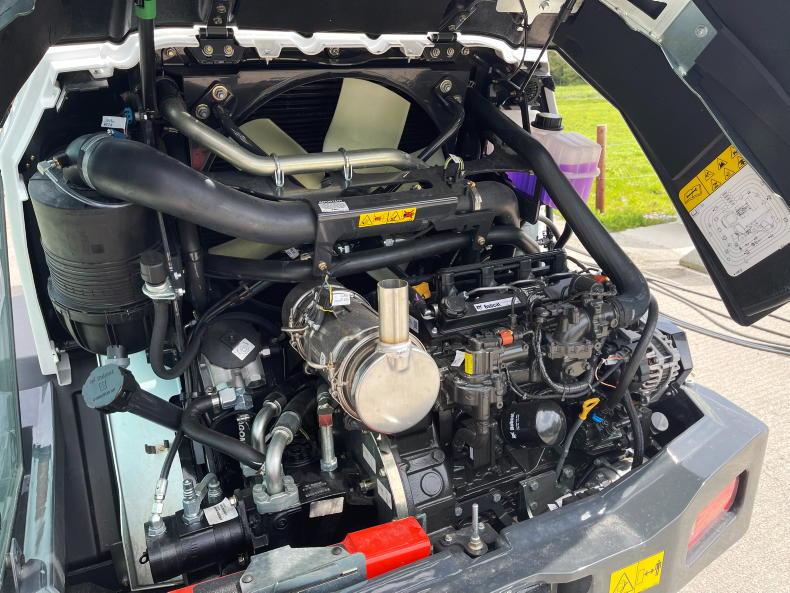
The engine bay provides great accessibility for both service and maintenance.
Both models comply with Stage V emissions regulations.
The engine is married up with a twin-range Rexroth hydrostatic transmission. Changes from low to high range can be made on the move which is a welcome feature not offered by some competitors.
In the low range, speeds of 0 to 9km/h can be achieved, while high-range speeds go from 0 to 20km/h (30km/h depending on the option).
Our model was only specified with the 20km/h max speed option which would have greatly benefited from the extra 10km/h.
Although a smooth transmission, we did find that it needed quite some revving to get going.
The inching pedal does its job but felt very much on or off with little in between.
To engage the differential locks, the button on the joystick must be pressed and held down.
Although not specified on our test model, Bobcat offers advanced attachment control mode whereby engine speed can be kept constant and from that forward speed can be adjusted using the foot pedal or vice versa. This particular feature would come in handy for applications such as sweepers or feeding buckets.
The automatic handbrake works well and always proves to engage straightaway once the loader comes to a stop or once neutral is engaged.
The L Series, like JCB’s TM Series, pivots through more than one axis in the centre. It oscillates here while the rear axle remains fixed unlike brands such as Weidemann and Manitou which keep the articulation fixed and opt for the oscillating rear axle.
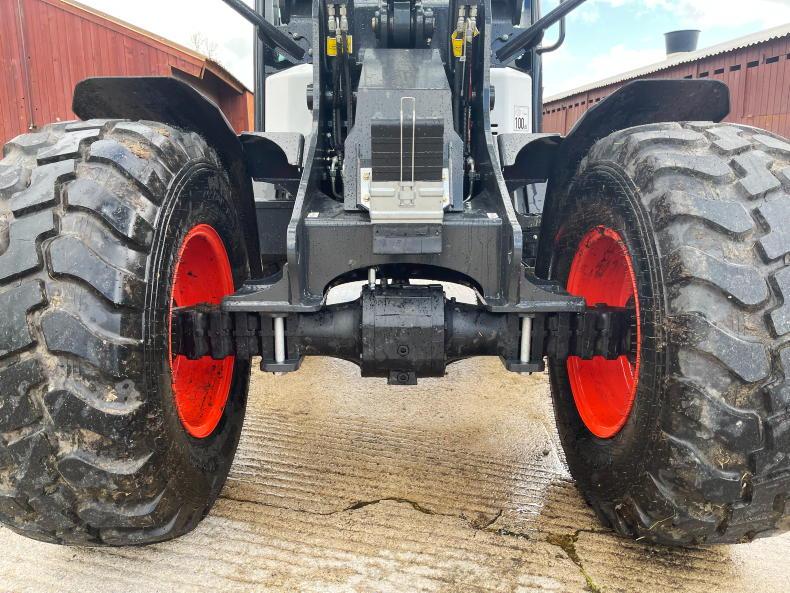
The L85 is fitted with Dana Spicer axles.

The central pivot also provides oscillation while the rear axle remains fixed.
The Bobcat L85 is fitted with a fixed boom and Z-bar linkage providing a parallel lift, typical of that seen on a larger construction loading shovel whereas many competitors in the ag segment offer either parallel linkage or a telescopic boom instead.
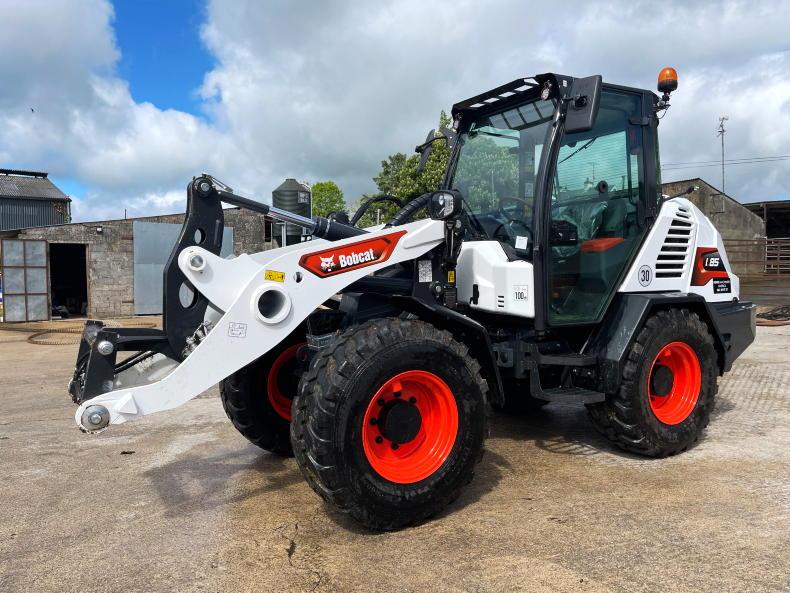
The large single ram of the Z-bar linkage provides a great tear out force.
The major selling point of the Z-bar linkage is its large single ram, which we found provided an excellent and responsive tear-out force.
Another benefit of the Z-bar linkage setup is unhindered forward visibility. Well most of the time – until the boom is lowered.
This is when visibility becomes slightly compromised – especially when hooking up to implements for the first few attempts until having got used to the machine.
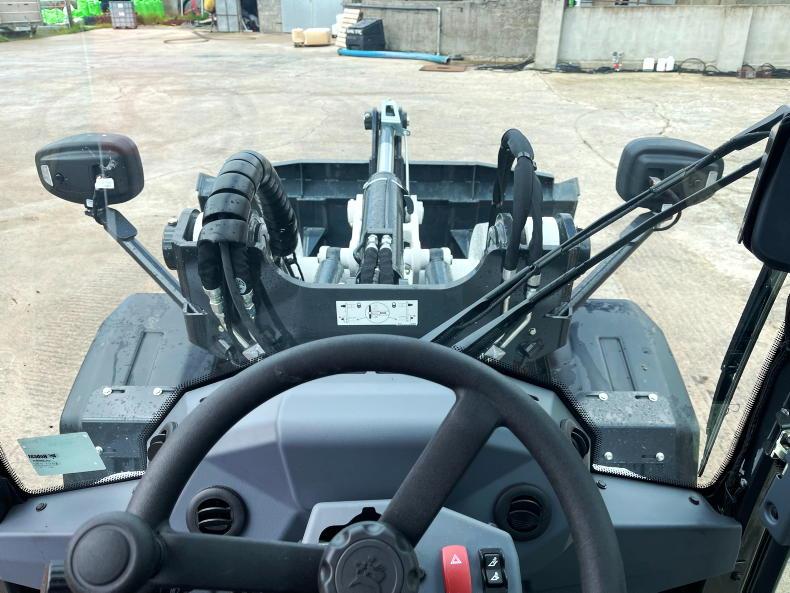
Visibility while hooking on and off implements is limited.
It features a straight tipping load of 3,800kg and tipping load of 3,151kg at a 40-degree articulation.
Lift height to the headstock pivot points measures 3.25m.
The latter is a respectable figure for a Z-bar linkage machine of such nature but perhaps a little on the low side if it is to load diet feeders, stack bales, etc, all tasks which would be expected from a loader of this size and capacity.
The boom features hydraulic dampening which can be switched on or off using the button positioned on the button positioned on the joystick.
Once turned on, it engages automatically over speeds of 5km/h.
The headstock locking mechanism is simply operated using the rocker switched located on the steering column. Both locking pins are spring-loaded to lock out, even in the event the operator forgets to lock the bucket or forks.
Providing hydraulic flow is the 75.4l/min hydraulic pump which is offered as standard. Although we found this to be perfectly sufficient, a 100l/min option is available.
The cab is easy to enter and provides ample space once in and seated. The fully glass doors to the right and left swing 180 degrees and can be locked open, if required.
Both the seat, joystick armrest and steering wheel are all adjustable.

The 5in LCD display screens are plain and simple.
Another feature we liked was that the armrest is suspended with the seat so both move together.
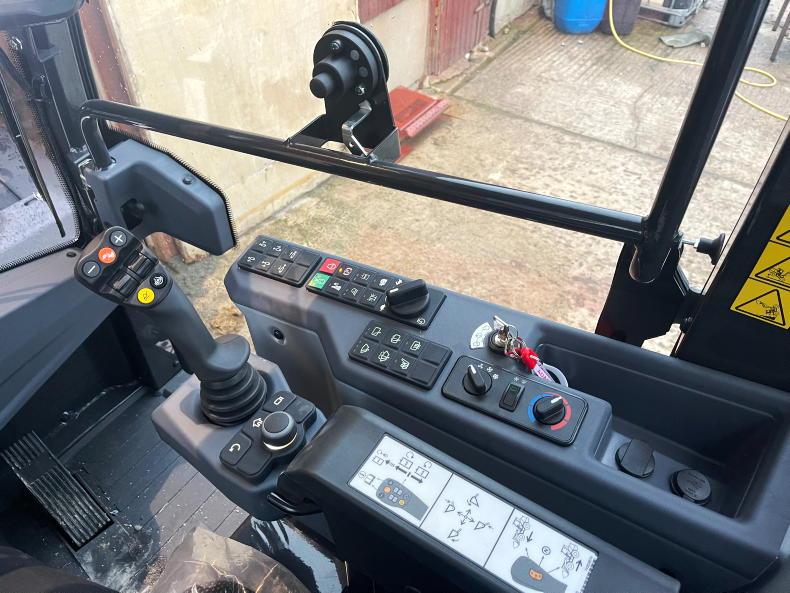
The control arm and switch panel has a clean well positioned layout.
On the armrest is the joystick and rotary encoder and three buttons, the latter for navigating through the 5in pillar mounted LCD display. Its screens are quite basic but, at the same time, display all the required machine vitals. All other switch gear is well positioned and is in the form of a rubber membraned blister pad, which runs alongside the armrest.
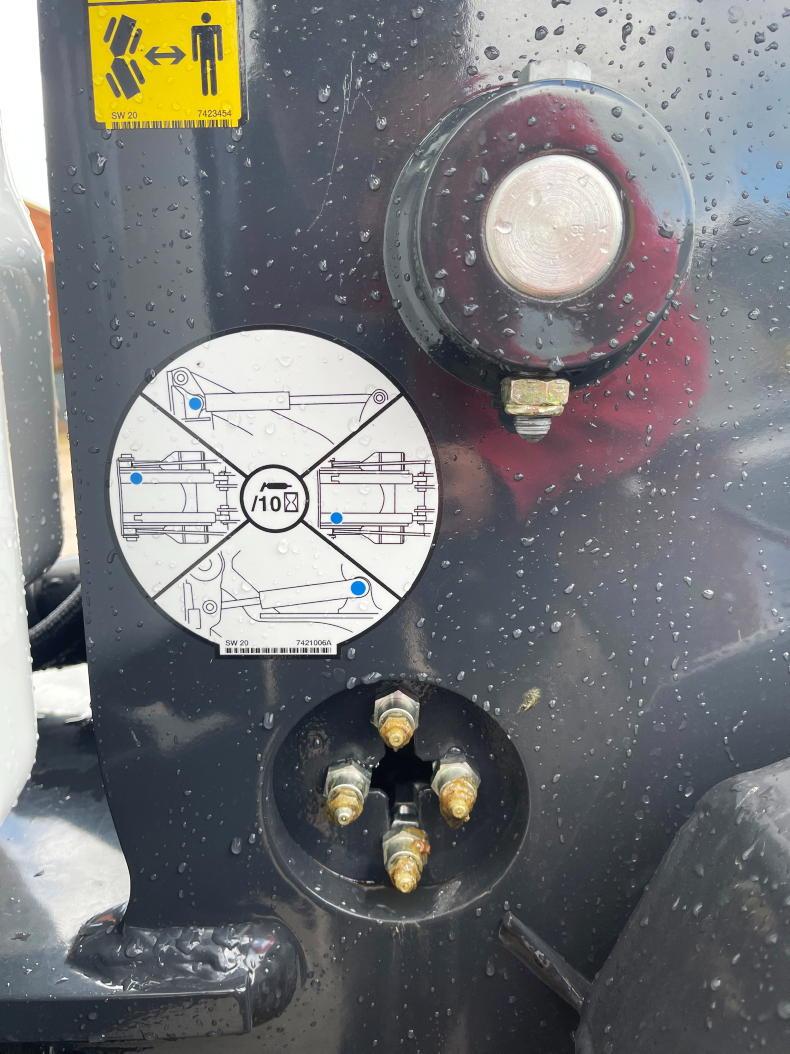
All grease points have been routed back to a central location.
The loader’s joystick we found was very responsive and precise which translated to excellent boom movements. A good test of the hydraulics’ responsiveness was the speed of a simple bucket shake while loading poultry manure.
Visibility all around cannot be faulted. This is helped by the full-length glass doors, tapered rear bonnet and curved front and rear glass windscreens.
Also integrated into the machine is a rear-view camera which is a nice touch. As said earlier, visibility becomes slightly compromised when hitching implements while the boom is lowered although this is something one would get used to.
Storage is good with a dedicated storage bin to the driver’s left-hand side. Air vents are good with plenty of outlets to keep the windscreen clear from misting. Air condition is optionally available.

Visibility is great once the implement is off the ground.
The full LED light package impressed us, especially the fully integrated LED headlights, dip beams, side lights and indicator units which tend to be halogen style on most machines still.
All in all, the L85 is a simple, straightforward machine to operate, which appears to have been built with the customers’ needs in mind. Not only is it simple to jump into and drive but underneath the bonnet, both the engine and transmission are well presented for service and maintenance, with its filters and radiators looking right at you.
The way in which all grease points have been routed to a central location is just another example of this.
Build quality too is top-notch with only one or two plastic surfaces inside the cab feeling as if they could have been made more premium.
Our machine was fitted with the larger 405/70 R20 Alliance tyres. A smaller 18in rim option is available, ideal for low sheds or poultry units.

The headstock locking pins are sprung, closing automatically if the operator forgets to do so.
The L85 has a total operating weight of 5,091kg. Although optional, we felt the 30km/h transmission is a must in a loader of this size, especially today with farms becoming more fragmented.
For the Irish market, the option of a telescopic boom would expand the appeal of the L Series to many farmers given the extra lift height.
As standard, Bobcat is offering the L Series with a two-year or 2,000-hour warranty with the option of an extended warranty up to five years, or 6,000 hours.
Engine: 2.4l Bobcat four-cylinder Stage V.Horsepower: 68hp (50.7kW). Transmission: two-speed hydrostatic motor. Max lift capacity straight: 3,800kg. Max lift capacity at 40 degrees: 3,151kg.Max lift height: 2.5m. Forward speed: 20km/h (30km/h optional). Hydraulic output: 75.4l/min. Operating weight: 5,091kg. Diesel tank: 78.8l litres. Tyres: Alliance 405/70 R20. List price as tested: €70,000 plus VAT.
Bobcat is no stranger to the compact loader segment, having pioneered the skid steer loader market in 1958.
Since then, the company has gone on to tick the excavator and side-boom telehandler market off its to-do list, now offering complete agricultural and construction ranges.
The next and current venture is in response to the growing demand for compact wheel loaders, both here in Ireland and the UK, as well as further afield on the continent. This has led to the introduction of the L Series compact articulated wheel loader range.
Last year, Bobcat announced the launch of this brand new, from-the-ground-up loader range, the L Series compact articulated wheel loader. Everything through from design to manufacture has been fully taken care of in house by Bobcat at its plant in Czech Republic.
Although it might have been the firm’s first attempt in the segment, fear not, the all-new range features a number of tried-and-tested brands when it comes to key components.
Some include Spicer axles, a Rexroth transmission and, of course, the Bobcat/Doosan four-cylinder engine.
With the first units having arrived in Ireland earlier this summer, we took the opportunity to put the flagship L85 model to the test on a typical mixed farm to see how it compared with its nearest rivals in what is a very competitive market segment.
Although initially launched as a one-model range, the L85 was quickly joined by a smaller brother, the L75 model, and is rumoured to expand further in the future.

The L85 is fitted with a 68hp 2.4l four-cylinder Bobcat engine.
The L75 is fitted with a 55hp engine and offers a straight tipping load of 2,953kg, while the larger L85 has a 68hp engine and straight tipping load of 3,800kg.
Engine and transmission
Both L Series loaders are fitted with Bobcat’s own 2.4l four-cylinder engine.
The main difference is the tune – the smaller L75 churns out a steady 55hp (41kW) while the L85 model produces 13hp more at 68hp (50.7kW).

The engine bay provides great accessibility for both service and maintenance.
Both models comply with Stage V emissions regulations.
The engine is married up with a twin-range Rexroth hydrostatic transmission. Changes from low to high range can be made on the move which is a welcome feature not offered by some competitors.
In the low range, speeds of 0 to 9km/h can be achieved, while high-range speeds go from 0 to 20km/h (30km/h depending on the option).
Our model was only specified with the 20km/h max speed option which would have greatly benefited from the extra 10km/h.
Although a smooth transmission, we did find that it needed quite some revving to get going.
The inching pedal does its job but felt very much on or off with little in between.
To engage the differential locks, the button on the joystick must be pressed and held down.
Although not specified on our test model, Bobcat offers advanced attachment control mode whereby engine speed can be kept constant and from that forward speed can be adjusted using the foot pedal or vice versa. This particular feature would come in handy for applications such as sweepers or feeding buckets.
The automatic handbrake works well and always proves to engage straightaway once the loader comes to a stop or once neutral is engaged.
The L Series, like JCB’s TM Series, pivots through more than one axis in the centre. It oscillates here while the rear axle remains fixed unlike brands such as Weidemann and Manitou which keep the articulation fixed and opt for the oscillating rear axle.

The L85 is fitted with Dana Spicer axles.

The central pivot also provides oscillation while the rear axle remains fixed.
The Bobcat L85 is fitted with a fixed boom and Z-bar linkage providing a parallel lift, typical of that seen on a larger construction loading shovel whereas many competitors in the ag segment offer either parallel linkage or a telescopic boom instead.

The large single ram of the Z-bar linkage provides a great tear out force.
The major selling point of the Z-bar linkage is its large single ram, which we found provided an excellent and responsive tear-out force.
Another benefit of the Z-bar linkage setup is unhindered forward visibility. Well most of the time – until the boom is lowered.
This is when visibility becomes slightly compromised – especially when hooking up to implements for the first few attempts until having got used to the machine.

Visibility while hooking on and off implements is limited.
It features a straight tipping load of 3,800kg and tipping load of 3,151kg at a 40-degree articulation.
Lift height to the headstock pivot points measures 3.25m.
The latter is a respectable figure for a Z-bar linkage machine of such nature but perhaps a little on the low side if it is to load diet feeders, stack bales, etc, all tasks which would be expected from a loader of this size and capacity.
The boom features hydraulic dampening which can be switched on or off using the button positioned on the button positioned on the joystick.
Once turned on, it engages automatically over speeds of 5km/h.
The headstock locking mechanism is simply operated using the rocker switched located on the steering column. Both locking pins are spring-loaded to lock out, even in the event the operator forgets to lock the bucket or forks.
Providing hydraulic flow is the 75.4l/min hydraulic pump which is offered as standard. Although we found this to be perfectly sufficient, a 100l/min option is available.
The cab is easy to enter and provides ample space once in and seated. The fully glass doors to the right and left swing 180 degrees and can be locked open, if required.
Both the seat, joystick armrest and steering wheel are all adjustable.

The 5in LCD display screens are plain and simple.
Another feature we liked was that the armrest is suspended with the seat so both move together.

The control arm and switch panel has a clean well positioned layout.
On the armrest is the joystick and rotary encoder and three buttons, the latter for navigating through the 5in pillar mounted LCD display. Its screens are quite basic but, at the same time, display all the required machine vitals. All other switch gear is well positioned and is in the form of a rubber membraned blister pad, which runs alongside the armrest.

All grease points have been routed back to a central location.
The loader’s joystick we found was very responsive and precise which translated to excellent boom movements. A good test of the hydraulics’ responsiveness was the speed of a simple bucket shake while loading poultry manure.
Visibility all around cannot be faulted. This is helped by the full-length glass doors, tapered rear bonnet and curved front and rear glass windscreens.
Also integrated into the machine is a rear-view camera which is a nice touch. As said earlier, visibility becomes slightly compromised when hitching implements while the boom is lowered although this is something one would get used to.
Storage is good with a dedicated storage bin to the driver’s left-hand side. Air vents are good with plenty of outlets to keep the windscreen clear from misting. Air condition is optionally available.

Visibility is great once the implement is off the ground.
The full LED light package impressed us, especially the fully integrated LED headlights, dip beams, side lights and indicator units which tend to be halogen style on most machines still.
All in all, the L85 is a simple, straightforward machine to operate, which appears to have been built with the customers’ needs in mind. Not only is it simple to jump into and drive but underneath the bonnet, both the engine and transmission are well presented for service and maintenance, with its filters and radiators looking right at you.
The way in which all grease points have been routed to a central location is just another example of this.
Build quality too is top-notch with only one or two plastic surfaces inside the cab feeling as if they could have been made more premium.
Our machine was fitted with the larger 405/70 R20 Alliance tyres. A smaller 18in rim option is available, ideal for low sheds or poultry units.

The headstock locking pins are sprung, closing automatically if the operator forgets to do so.
The L85 has a total operating weight of 5,091kg. Although optional, we felt the 30km/h transmission is a must in a loader of this size, especially today with farms becoming more fragmented.
For the Irish market, the option of a telescopic boom would expand the appeal of the L Series to many farmers given the extra lift height.
As standard, Bobcat is offering the L Series with a two-year or 2,000-hour warranty with the option of an extended warranty up to five years, or 6,000 hours.
Engine: 2.4l Bobcat four-cylinder Stage V.Horsepower: 68hp (50.7kW). Transmission: two-speed hydrostatic motor. Max lift capacity straight: 3,800kg. Max lift capacity at 40 degrees: 3,151kg.Max lift height: 2.5m. Forward speed: 20km/h (30km/h optional). Hydraulic output: 75.4l/min. Operating weight: 5,091kg. Diesel tank: 78.8l litres. Tyres: Alliance 405/70 R20. List price as tested: €70,000 plus VAT. 














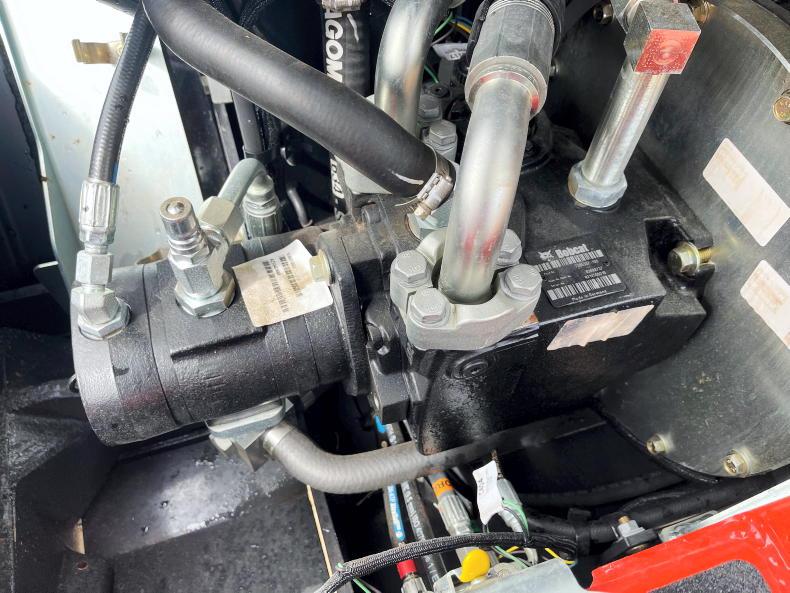

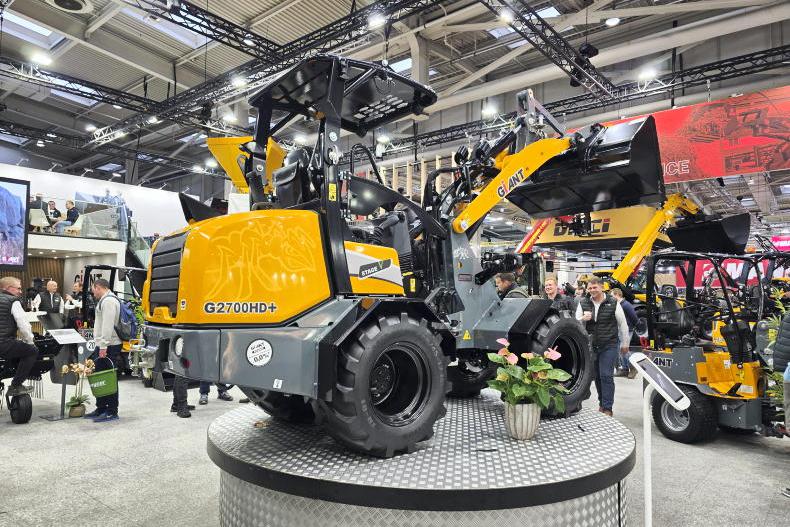



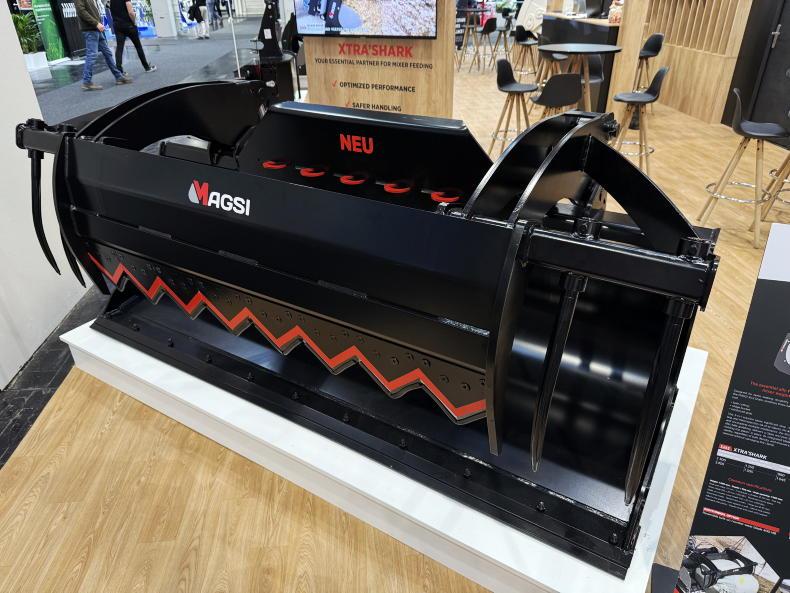
SHARING OPTIONS